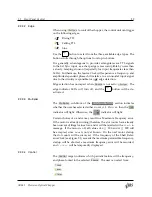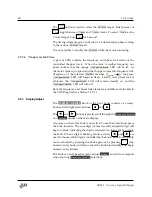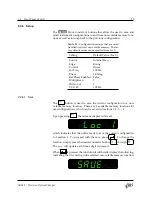
2.1 Functional Overview
23
Source
Shaft
Inner (N=5)
Outer (N=6)
Edge
CONFIGURATION
×1
Multiplier
Control
T
Source
T
Inner
= T
Source
Phase = +90°opt
+18°mech
Inner
Figure 2.6:
Simulated timing diagram of rear‑panel outputs for Inner Slots con‑
trol with
𝑛
slots
= 5
and +90
°
phase offset. The
Rotor Shaft Ref Out
and
Inner Slots
Ref Out
signals with a 0
°
phase offset from Figure 2.5 are shown as faint dashed
lines for easy comparison. Width of
Rotor Shaft Ref Out
pulse is exaggerated
for illustrative purposes.
The user’s own chopped optical signal will likely experience a differ‑
ent, but still systematic, offset relative to
Source Out
, owing to the dif‑
ference in position between the inner track slotted opto‑interrupter and
the user’s beam path.
Once the
Phase
setpoint has been adjusted to provide the desired offset
between the source and control signals, that phase can be set as the 0
°
reference point (to which further adjustments are relative) by pressing
Rel
Phase
.
2.1.3
Shutter Mode
In addition to the traditional
chop mode
, the SR542 can be used as an
optical shutter. While not to be used for precisely timed signals (see
the SR475 Laser Shutter for such applications),
shutter mode
can be use‑
ful for temporarily blocking or unblocking the beam path to test optical
alignment or signal levels, or for prohibiting downstream exposure to
the blocked beam.
To configure the the SR542 for
shutter mode
, choose
Internal Freq
as the
Source
, and set
Int Freq
to 0 Hz. In this mode, the chopper blade is held
in a fixed (static) position, with angular orientation set by the
Phase
setting.
To understand this mode of operation, Figure 2.7 provides an example
case with the SR542 controlling the position of the Outer slots. By chang‑
ing the
Phase
from 0
°
to 180
°
the user can alternately pass or block the
SR542 Precision Optical Chopper















































